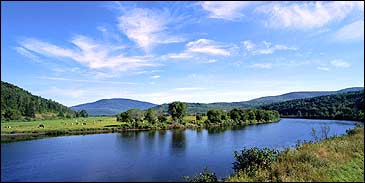ONE WARM MORNING EARLY LAST JUNE, we carried our canoes at the shore of Brighton Pond, deep in Vermont’s boreal Northeast Kingdom, and carried them over the narrow divide separating the Nulhegan and Clyde River watersheds. It was a fairly short portage, a nearly level stroll on a well-beaten path under tall white pines. Not five minutes later, we came upon the tracks of the St. Lawrence and Atlantic Railroad and followed them 200 yards to a tea-colored tamarack bog—perhaps the shortcut we were seeking to the Nulhegan. We put in and drifted toward a narrow blue horizon throughaisles of balsam and spruce.
It was National Trails Day, and my wife and I had joined six members of Native Trails Inc., a nonprofit outfit dedicated to identifying and preserving precolonial and preindustrial travel routes, on a scouting detail. With us was one of its founders, Ron Canter, a cartographer at the National Oceanographic and Atmospheric Administration, as well as Maryland-based computer expert and waterman Randy Mardres, and Mike Krepner, a Maine guide.
Our goal that day was to check out the portage route and then run the Nulhegan 15 miles to the Connecticut River. It was the latest in a decade of outings Native Trails has led as the group has pieced together the 700-plus-mile Northern Forest Canoe Trail. The NFCT, a (mostly) fluvial Appalachian Trail, includesthe storied and popular canoe waters of the Adirondacks and Maine at either end, but its interior connections, such as the Nulhegan, have attracted little use since the days of log drives in the late 1800s. We wanted to make sure nothing besides a few short portages and beaver dams blocked the way.
As you might expect, creating the NFCT has been a long haul, but the vision Native Trails outlined ten years ago, based on colonial records and maps, is nearing reality. To promote and maintain the trail, a separate nonprofit named the North Forest Canoe Trail was formed in 1999. The organization is run by Kay Henry and Rob Center, former executives of Waitsfield, Vermont-based Mad River Canoe who view the trail as an opportunity for increased economic vitality and historical awareness. The seasoned managers have already won corporate and foundation grants, and have organized a network of volunteers to maintain waterways, campsites, and information centers.
While every mile of the NFCT follows colonial routes, its final shape has been updated to accommodate changes in the watercourses. The trail begins at Old Forge, in New York’s Adirondack Park, and roars down the Saranac, with its sections of Class II and III whitewater, to Lake Champlain. From there, it enters the Mississquoi River and, after a good deal of upstream paddling and poling, lets you out at the Clyde-Nulhegan watershed, where we started out that morning. Reaching the Connecticut River, the NFCT next hooks up with the Ammonoosuc River, cuts across New Hampshire’s northern neck, and wends up the steep, spectacular Rapid River to Maine’s Rangeley Lakes at Fort Kent. It ends at the Canadian border.
There are still some kinks to sort out. Snags and downed trees from spring runoffs have yet to be cleared. Short sections of portage trail, like the one connecting the Clyde to the Nulhegan, need brushing out and marking, and information isn’t complete for every segment of the route. Leaving Brighton Pond that day, we had little idea what to expect.
We paddled the Nulhegan’s twisty headwaters, cutting away blowdown, and on through the middle reaches of deep current to the swift lower miles. Toward day’s end we came to the head of a lovely Class II rapid with a narrow line of waves cushioning the rocks. We ran it, Ron Canter poling his canoe from a standing position. Eventually we rounded a bend and confronted a maze of boulders blocking the widening stream. While the rest of us watched, one of the men soloed his boat down the rock garden, only to run aground.
A party of long-haulers might have chosen to camp there and reach the Connecticut in the morning. But we called it a day and hiked back to the highway. On a low rise above the railroad bridge, we looked back up the valley, a scene on par with anything depicted by 19th-century painters. The view reminded me of what I love most about the NFCT: its natural beauty and timelessness.
Like a golf course that requires every club in the bag, the northern Forest Canoe Trail demands a full range of skills, including experience negotiating short stretches of Class III whitewater. Through-paddlers should know how to pole and should allot at least eight weeks to complete the trail, something that hasn’t been done yet.
When To Go: May/June or September/October are the best months, as campsites are more readily available and the water is higher.
Getting Primed: Build up to the long haul by paddling short sections first. For information on trail conditions, call the NFCT at 802-496-2285, or check out: . Also, I highly recommend Adirondack Canoe Waters: The North Flow, by Paul Jamieson (available through the Adirondack Mountain Club, 800-395-8080; ).
Staying There: The NFCT passes directly through several towns, so there’s easy access to inexpensive motels and cozy B&Bs. For base camps, however, try The Wawbeek, on Upper Saranac Lake, New York (518-359-2656), Northbrook Lodge, in Paul Smiths, New York (518-327-3379), and The Birches, in Rockwood, Maine (207-534-7305).
Outfitters: You’ll find a dozen or more supply-rental outfits and other services along the way, among them Mac’s Canoe Livery, Route 30, Lake Clear, NY (518-891-1176) and Nulhegan Guiding, 1506 Route 114, Island Pond, VT (802-895-4328). Mac’s Canoe Livery’s rates are typical: $25 a day for Royal X canoes, $40 a day for Kevlar, and $50 a day for graphite.


